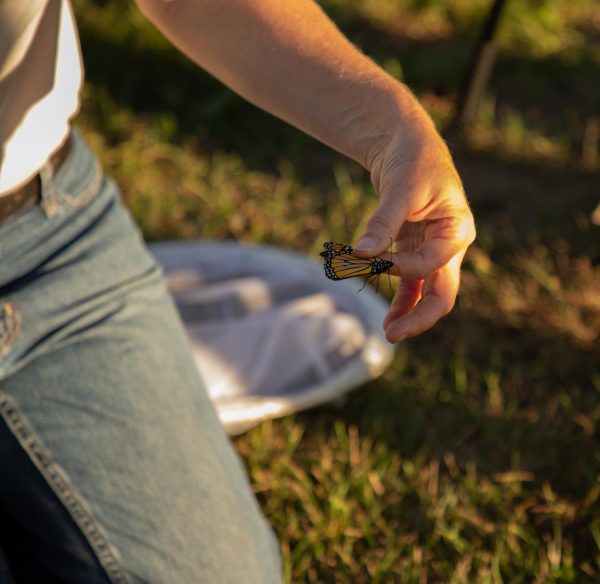
Sara Eddington
Missouri Ph.D student Isuru Lakshika Weligama Arachchige carefully holds a newly tagged monarch butterfly on Thursday, September, 25, during the Monarch Migrations event at A.L. Gustin Golf Course. Monarch butterflies are tagged to track their migration south during the winter months.
Isaac Breuer, course superintendent of A.L. Gustin Golf Course, tells people he has the best office in Columbia.
The A.L. Gustin course is an 18-hole golf course owned and operated by the University of Missouri, but what Breuer loves most about it is the 10 acres of pollinator plots and native Missouri plants that thrive in the course’s out-of-play areas.
These pollinator plots support Missouri wildlife, particularly bees and butterflies. Monarch butterflies were the main attraction on Thursday, Sept. 25, when Sustain Mizzou worked with the Missouri Conservation Corps to host a monarch tagging event at the golf course.
Laura Semken, a naturalist working with the Missouri Conservation Corps, has been tagging monarchs for five years.
“We’re doing this to find out where they go, how long they survive, where they come back to and what their whole life cycle is, so that we can help understand how to make sure they thrive and don’t disappear,” Semken said.
Semken passed butterfly nets out among the 14 students in attendance, demonstrated how to catch a monarch without hurting it and then walked with the students as they searched among the milkweed and goldenrod for monarch butterflies.
Although the students were unable to catch any monarchs, Semken caught one and showed the students how to tag it. She held the butterfly’s wings gently between her thumb and index finger, then placed a small tagging sticker on one wing.

The tagging stickers are from Monarch Watch, a program that focuses on monarch habitats and migration patterns. As monarchs migrate to Mexico, volunteers tag monarchs and log the sticker code of any butterflies that were previously tagged.
In 2024, 757 monarchs were recaptured and logged throughout North America. This tagging data helps Monarch Watch understand what changes need to be made to help monarch populations
“Monarch Watch puts out an enormous amount of research papers, and they print newsletters,” Semken said. “They make suggestions for habitat restoration, like planting milkweed, where to plant it, what kinds to plant.”
Monarch populations in Mexico have been steadily declining since the 1990s, in part due to dwindling milkweed in breeding habitats and along migration paths.
“[Monarchs] may be put on the endangered species list. So it’s very important that as [this] generation flies south to overwinter in Mexico, that they have food on the way down,” Breuer said. “If every golf course had pollinator plots with milkweed from Minnesota to Mexico, it would really, really help them out.”
However, not every golf course has the ability to support monarch butterflies like A.L. Gustin does.
“It’s a lot harder for people to do this type of work at a country club because the members think it looks weedy or out of control,” Breuer said. “A lot of times, the country club members, they want green grass. Everything is perfectly manicured. They don’t want to look at something like this, even though there’s 25 different types of native plants in here, and you can see the wildlife.”
These habitats may not be possible on every golf course, but through widespread programs like Monarchs in the Rough, hundreds of golf courses across North America have planted milkweed on their property to boost monarch populations.
As monarch butterflies fly thousands of miles this fall, golf courses across the continent are ready to support their migration – including “the best office in Columbia.”
Edited by Jae Jepsen | [email protected]
Copy edited by Alana Sheba and Emma Harper | [email protected]
Edited by Chase Pray | [email protected]